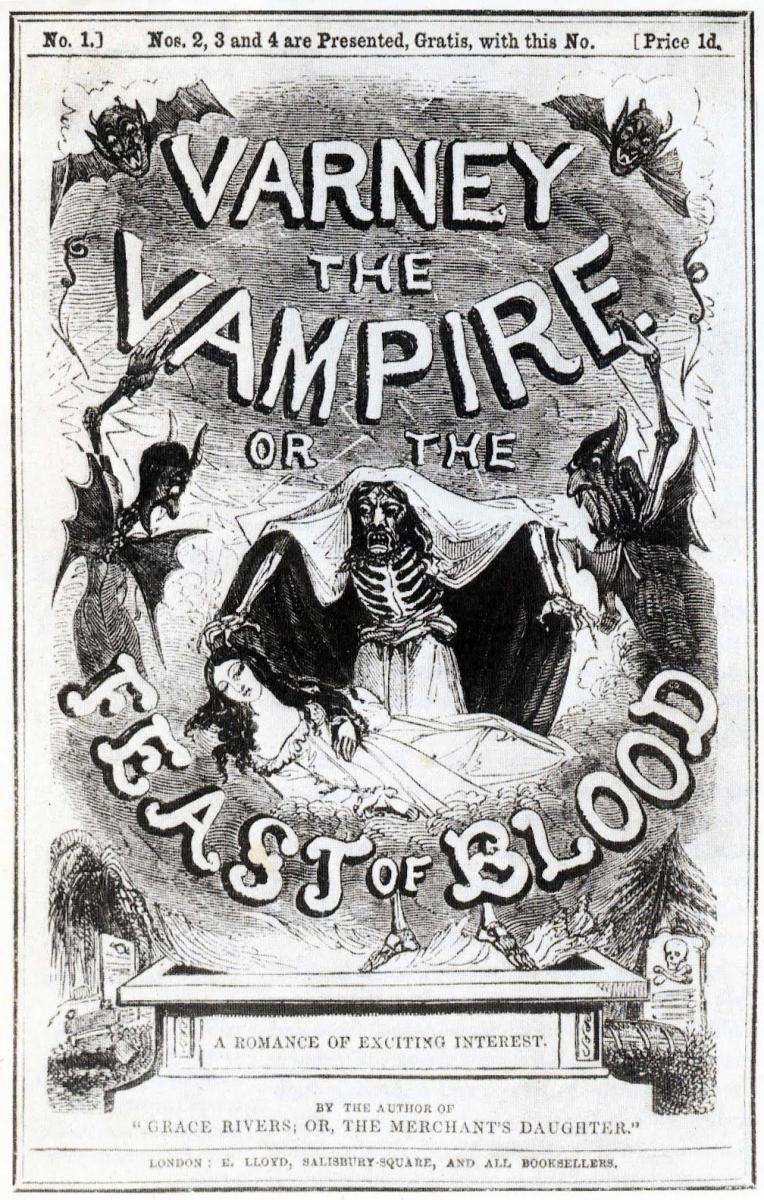Varney The Vampire
Created by Charles Rowell on Mon, 11/11/2024 - 22:47
Part of Group:
Varney the Vampire, written by James Malcolm Rymer, was a serialized gothic horror story in weekly pamphlets better known as “penny dreadfuls” from 1845 to 1847. Once the original run was completed all of the Varney the Vampire chapters were compiled into a book in 1847. The story of Varney the Vampire can be split into two halves, the first being Varney terrorizing the family of the Bannerworths, and the second being Varney trying to get married but being foiled by Admiral Bell and Jack Pringle. Most of the plot beats in Varney have become major staples in future vampire literature. This is because Bram Stroker’s Dracula took major influence from both the story and the character of Varney.
Both Varney and Dracula are very similar. Both have weaknesses in garlic, crucifixes, and wooden stakes, and both feed entirely on blood. Also, both vampires have supernatural powers and prey on young women. Not only are the main vampires similar but also some plot beats. For instance, both stories involve the vampires taking advantage of young women and attempting to turn them into vampiric lovers, all while being stopped by a group of men. Additionally, both stories have similar themes of fear, seduction, and the struggle between good and evil.
These similarities are Varney’s main claim to fame, as some modern scholars have dismissed Varney as trashy media that is not worth looking at in an academic sense. Such as when Leonard Wolf wrote that ‘there is nothing in Varney, nothing at all, that is capable of sounding anything like the chords of dark understanding that reverberate in page after page of Stoker’s Dracula’ (1972: 170) or when Bette B. Roberts insists that “Varney’s contributions to the [vampire] myth are superficial and physical rather than substantial and psychological’(1987: 4). Varney was indeed trashy media for the masses, but there is still enjoyment to be found in consuming that material. Sometimes people need entertainment to escape from the real world, and reading Varney is almost a time capsule into that world. Not only that, but we are no better today as we most definitely have even more trashy media than the Victorians.
But at the same time, there are aspects of Varney that are imported for the larger myth of the vampire, other than just inspiring Dracula. The biggest aspect of the vampire myth that started with Varney was the first major vampire to be not entirely wicked. While previous vampires such as Lord Ruthven in Polidori’s “The Vampyre” are seen as constantly doing evil things and attempting to corrupt those around them, Varney in later stories is shown in a more sympathetic light. He is shown to be a slave to the curse of vampirism instead of reveling in his powers. This nuance adds a layer of complexity to the character, portraying Varney not merely as a villain but as a tragic figure trapped by his condition. This empathetic portrayal paved the way for future depictions of vampires that explore the internal struggles and moral ambiguities of these creatures. By humanizing Varney, Rymer's work contributed significantly to the evolution of the vampire myth, making it richer and attempting to evolve the vampire from a one-note monster to a tragic figure.
In the end, Varney the Vampire holds a significant place in gothic literature despite its reputation as a piece of sensationalist media. Varney has been a fundamental piece of the DNA of vampire literature. The character of Varney introduced complexities to the vampire myth, portraying him as a tragic figure rather than a mere embodiment of evil. This nuanced approach allowed for richer storytelling and deeper exploration of the vampire’s nature in future literature. Varney's legacy, though dismissed by some scholars, remains an essential chapter in the evolution of the vampire narrative, demonstrating that even the most "trashy" media can offer valuable contributions to cultural and literary traditions.

